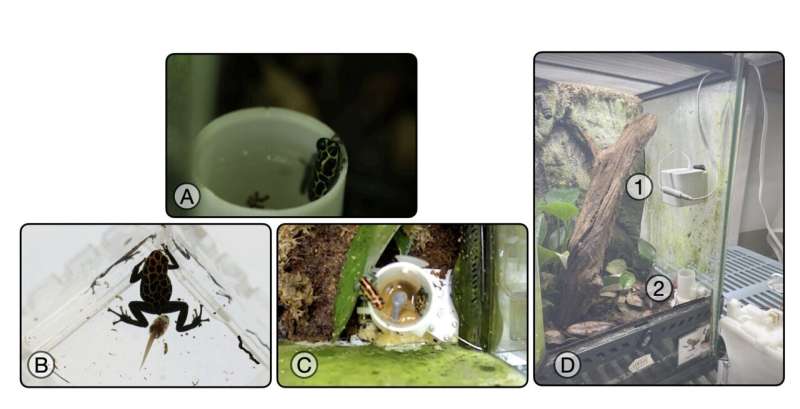
Over the past few decades, roboticists have developed robots inspired by a wide range of animals, including dogs, snakes, birds, spiders, bats, octopus, and different types of insects. These robots were primarily designed to tackle real-world practical problems, for instance entering narrow spaces, moving on uneven terrains or reliably flying over long distances.
A team of researchers at Stanford University recently developed a small robot that looks like a tadpole and then used it to study the parenting behavior of poison frogs (R. imitator), a type of poisonous and brightly colored frog native to Central and South America. Their paper, published on the arXiv pre-print server, presented some very interesting observations, both in terms of how the frogs reacted to the robot and their behavior with their offspring.
“Animal models offer a treasure trove of how organisms respond and adapt to ecological pressures,” Billie C. Goolsby, one of the researchers who carried out the study, told Phys.org. “We are interested in poison frogs because they exhibit immense behavioral diversity, especially in terms of parental care. Because many frogs recognize space rather than kin directly (i.e., though facial recognition), we can opportunistically manipulate tadpole pools, or nurseries, with robotic tadpoles to see how parents respond in changes of offspring signals. For a lot of other species, this isn’t possible, because parents recognize kin directly or there are other signals that we have to account for, such as sibling competition.”
Some previous studies also tried to introduce robotic frogs into the same environment as real frogs, generally to observe their social behavior and decision-making. Goolsby and his colleagues, on the other hand, specifically wished to investigate whether a tadpole-like robot would somehow influence the parenting behavior of poison frogs.
One behavior that was of particular interest to them is the commonly observed tendency of poison frog mothers to release unfertilized eggs and feed them to their offspring, after the latter exhibit “begging” behavior (i.e., approaching the frog’s backside while vigorously wiggling their tail). They also wished to study behavior of father frogs, who generally inspect nurseries and evaluate offspring, to determine which ones are in greater need of feeding.
“The specific species we study evolved maternal provisioning, which is where mothers release unfertilized egg meals to begging offspring,” Goolsby explained. “Maternal provisioning is coordinated by paternal calling, where fathers also monitor nurseries to evaluate offspring. We study parental visitations, paternal calling, and maternal provisioning as facets of parental effort in this species.”
To conduct their experiments, the researchers first created a small robot that can emulate the wiggly body movements of tadpoles. They then introduced this robot inside a large aquarium tank with father and mother poison frogs, remotely controlling their movements so that they replicated the tadpoles’ begging behavior.
“A motor outside of our robot rotates a crank, which pulls a string that’s attached to inside of the robot,” Tony G. Chen, another researcher involved in the study, said. “So, this along with the spring element that’s inside of the robot, pulls and pushes the tail of the TadBot, producing the wiggling motion. The main advantage of this setup is that it allows the TadBot to be really small, close to the size of a real tadpole.”
The robot created by Goolsby, Chen and their colleagues closely resembles tadpoles in size, appearance and movements. Notably, its motor can be mounted outside an aquarium tank, to prevent the noise it produces from alarming the frogs or interfering with their normal activities.
The researchers found that the robot “passed the test” and fooled the parent frogs, particularly father frogs, who appeared to treat it as if it were one of their offspring. In many cases, when the tadpole-like robots started “begging” and vigorously wiggling their tail, the fathers tried to coordinate care, calling the mothers to the nurseries so that they could feed the robots unfertilized eggs.
Interestingly, while the mothers answered the call and visited the tadpole nursery, they did not release the unfertilized eggs, suggesting that they somehow realized that the robots were not offspring. In their paper, the researchers suggest that the mothers may rely on additional signals when trying to decide whether to deposit an egg or not, such as vibrations or other subtle movements.
“We hope that our work can provide a toolkit that can be tractably used to manipulate offspring signals, informing us how vibrational cues may be represented in an amphibian and where parental decision-making occurs in the brain,” Goolsby said. “Combining these findings, we can begin to better understand the ancestry and evolution of the neural circuitry involved in parenting.”
The recent study by Goolsby, Chen and their colleagues highlights the vast potential of robots for safely studying the social behavior of animals. In the future, it could inspire new works aimed at developing bio-mimetic robots, using them to interact with different animal species and observing the resulting behavior.
“We now plan on improving TadBot mechanically to be more like a real tadpole based on the data we have been gathering, while also conducting further behavioral studies,” Chen added.
More information:
Tony G. Chen et al, Feed Me: Robotic Infiltration of Poison Frog Families, arXiv (2023). DOI: 10.48550/arxiv.2305.14570
Journal information:
arXiv
© 2023 Science X Network
Citation:
Studying the parenting behavior of poison frogs using tadpole-like robots (2023, June 20)
retrieved 23 June 2023
from https://phys.org/news/2023-06-parenting-behavior-poison-frogs-tadpole-like.html
This document is subject to copyright. Apart from any fair dealing for the purpose of private study or research, no
part may be reproduced without the written permission. The content is provided for information purposes only.










